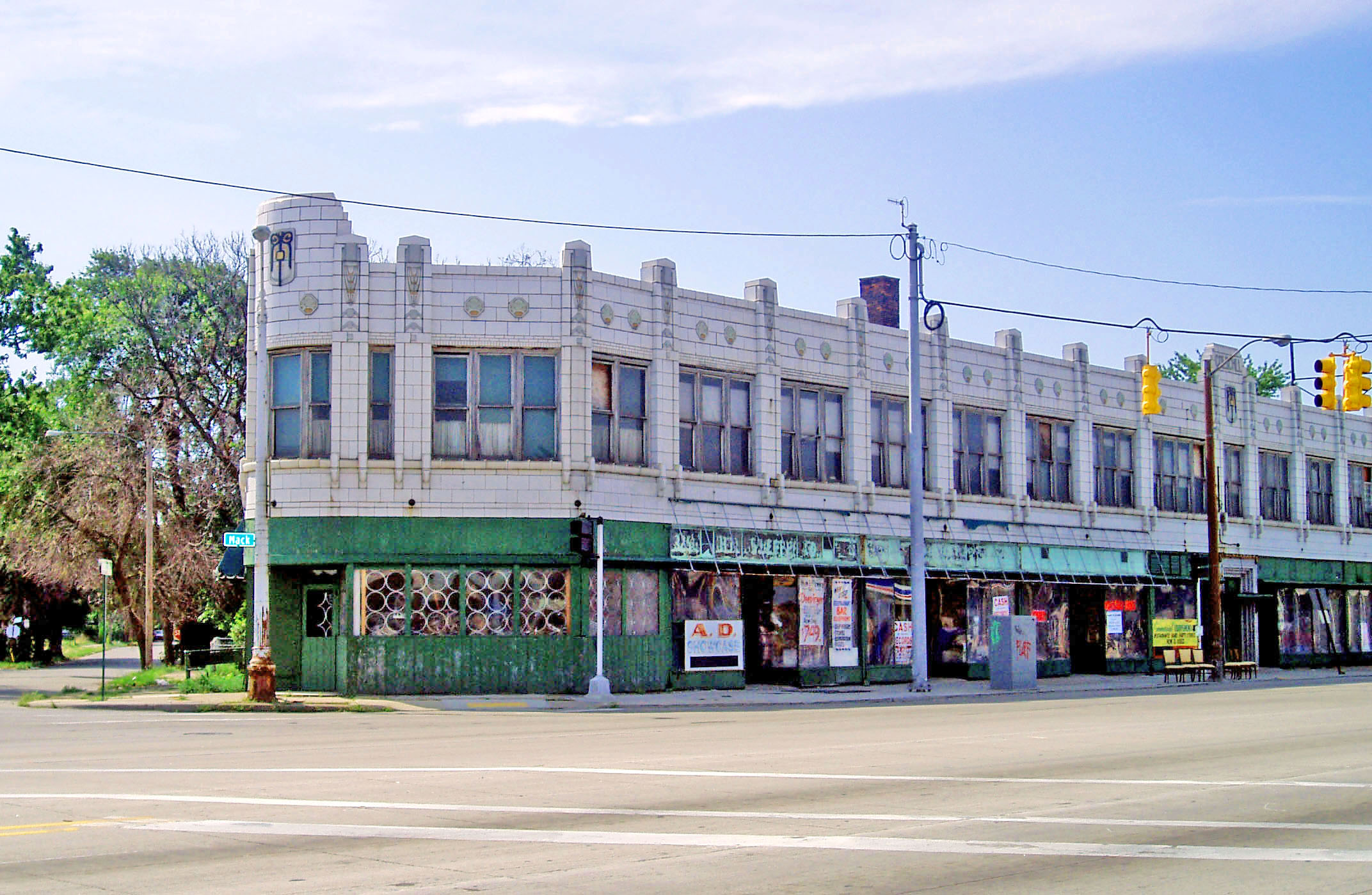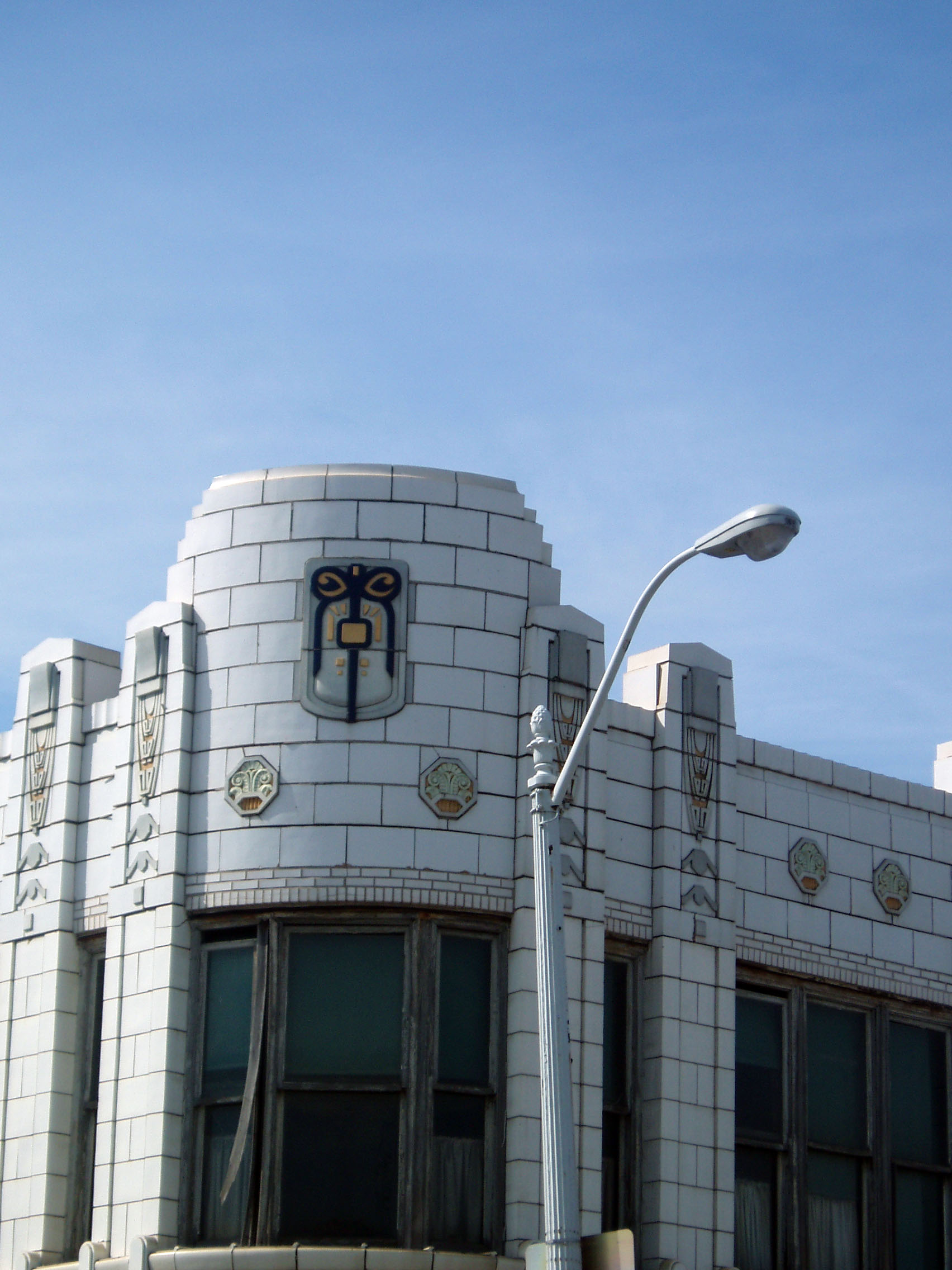

If you walked through or drove around the residential neighborhoods of cities that grew rapidly during the 1920s, you would see many structures similar in size to this one. Very few of them would be as attractive as the Goeschel Building. Land was not extremely expensive so developers did not have to build many-storied buildings to get satisfactory returns on their investments. Two-story buildings were the rule. On the ground floor, commercial space was rented to merchants who sold their wares to the neighborhood’s residents. On the second floor, there was office space for professionals whose clients resided nearby—dentists, doctors, lawyers and a few bookkeepers. At that time most doctors had an office in the neighborhood whose residents they served and many or most practiced medicine on their own. The idea of doctors maintaining their offices in a hospital or medical clinic was a development of the 1960s.
This was among the earliest Art Deco building constructed in Detroit. It opened on September 6, 1914. The building you see differs from most such building because of how faithfully the architects executed the Art Deco design. If you look to the roofline, you will see an array of interesting designs that appear only in Art Deco buildings. I find them attractive. They certainly are different from the gargoyles and roofline embellishments used in the late Nineteenth Century. At the building’s attractively curved prow pointed at the intersection of Mack and Gratiot, you see a colorful design in green that distinguishes the structure. And the name of the developer, Goeschel, appears in a bold Art Deco script above the Gratiot Avenue entry where customers entered, then  climbed stairs to see their doctor or dentist. The white glazed terra cotta tile must have gleamed in the sunlight when the building was new. At the time of its installation, there was a belief that terra cotta would need very little maintenance and would, more or less, gleam for years on end. Those expectations proved false. Presumably, it would gleam once again were this building renovated. Alas, the population in the nearby neighborhoods has fallen sharply since the 1950s so investors may think twice about putting funds into this structure.
climbed stairs to see their doctor or dentist. The white glazed terra cotta tile must have gleamed in the sunlight when the building was new. At the time of its installation, there was a belief that terra cotta would need very little maintenance and would, more or less, gleam for years on end. Those expectations proved false. Presumably, it would gleam once again were this building renovated. Alas, the population in the nearby neighborhoods has fallen sharply since the 1950s so investors may think twice about putting funds into this structure.
Originally, this building included three stories. There was space for five commercial or retail stores on the ground floor. The second story had space for five office suites. The third floor provided space for light manufacturing. In 1931, there was a major renovation of the structure and third floor was removed. Long after most tenants left, the ground floor was used by a merchant who sold restaurant equipment.
This building was constructed as an investment by Otto C. Goeschel who was born in 1862. By the mid to late 1890s, he was very active in the Republican party in Detroit. He was an associate and strong supporter of reform Mayor Hazen S. Pingree whose statue graces Grand Circus Park. Goeschel served the city as auditor from 1895 to 1897 and then was elected alderman from the Thirteenth Ward in 1898. He was a strong supporter of providing free water to city residents and encouraged the paving of streets and sidewalks long before automobiles sold in great numbers. He served on the commission that laid out the planning for the new Michigan Central Depot that opened in 1913.
The architects for this Art Deco building certainly designed in several different styles. They were responsible for the Detroit Electric Car Company Charging Station B Building at 100 East Grand Boulevard. Perhaps some will be surprised to learn that there were once so many Detroit Electric Cars in use in the city that the manufacturer built a charging station very near Belle Isle. Presumably, pleasure seekers drove to the charging station that Mildner and Eisen designed, left they electric car, enjoyed Belle Isle for several hours and then returned to their repowered Detroit Electric. Mildner and Eisen also designed that church where Reinhold Niebuhr served as pastor—the German language Bethel Evangelical congregation at 2270 West Grand Boulevard at the fringe of the New Center neighborhood. Niebuhr was, arguably, the most famous theologian to come from Detroit. The church that Pastor Niebuhr built is now Missionary Baptist.
Architect: Mildner and Eisen
Architectural style: Quintessentially Art Deco
Date of construction: 1914
Use in 2012. Until recently a restaurant supply store used ground floor commercial space. The building appears to be underutilized.
Information about this building: http://historicdetroit.org/building/goeschel-building/
Book concerning Art Deco in Detroit: Art Deco in Detroit by Rebecca Binno Savage and Greg Kowalski (Charleston, S. C.: Arcadia Press, 2004)
Website of the Detroit Area Art Deco Society: http://www.daads.org/
City of Detroit Designated Historic District: Not listed
State of Michigan Registry of Historic Sites: Not listed
National Registry of Historic Places: Not listed
Photograph: Ren Farley, August 11, 2007
Description updated: July, 2012
Return to Commercial Buildings